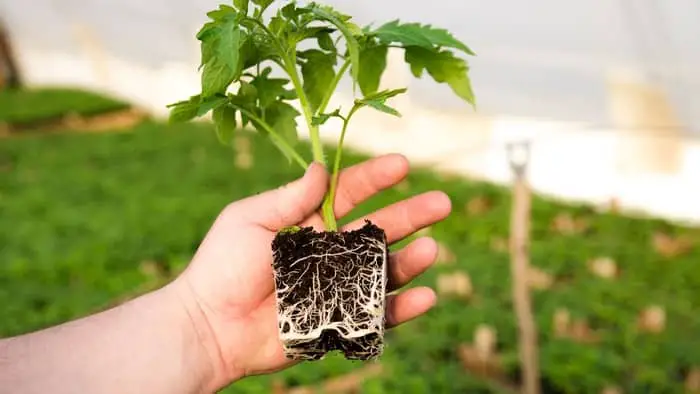Last Updated on October 26, 2022
If you are thinking of growing tomatoes, it is important to know just how deep do tomato roots grow to prepare your soil before planting.
Tomatoes are a warm-season vegetable and like most plants, they need to be grown in the right type of soil to perform at their best. This article will help you understand how deep your roots should be planted. This will help ensure that you prepare the correct soil for your tomato plants to grow in.
You can use this information to ensure that you plant your tomatoes in the correct soil. In addition, you can also ensure that your plants are growing in the right way.
How Deep Do Tomato Roots Grow?
So, how deep do tomato roots grow? The depth of your roots depends on the type of soil you are planting in.
In most cases, tomato roots will grow between two to three feet. It is important to know just how deep you need to plant your tomato roots so that you can ensure that the soil is prepared correctly before planting.
Here are some of the types of soil you can plant your tomatoes in.
Type 1: Loam soils
Read more about Timber Grow Lights For Plants – Grow Light Info.
FAQs
How deep and wide do tomato roots grow?
The roots can reach a depth of two to three feet, with lateral roots reaching up to two feet. In the field, they grow as a network of fine roots that are used to absorb water and nutrients from the soil.
Is 12 inches deep enough for tomatoes?
You should provide tomato plants with at least two to three feet of depth to provide them plenty of room to grow.
How deep should a raised garden bed be for tomatoes?
The depth of the raised garden bed should be at least 12 inches deep.
How deep do cherry tomato roots grow?
Cherry tomatoes roots will grow to be around two feet deep.
These types of soil are composed of loam and sand, with low clay content. These soils are good for growing root crops such as beans, carrots, and lettuce. The rich, organic matter in loam soil will help your tomatoes grow large and flavorful.
Loam soil is great for holding moisture while still providing proper drainage. It works well for a variety of plants.
Type 2: Sandy soils
Sandy soils are made up of gritty textures including sand and gravel, often with high sand content. These soils are pracical for growing root vegetables and herbs native to the Mediterranean. Tomatoes can grow in sandy soil that is slightly acidic.
Type 3: Clay soils
These types of soil are composed of very fine mineral particles, with high clay content. Clay soil provides tomatoes with important nutrients to grow strong and healthy. However, clay soil can be heavy so it is best to mix it with another type of soil.
Type 4: Peat soils
Peat soil is made from organic materials that have been decomposed. They are good for growing root crops such as parsnips, turnips, radishes, beetroot, carrots, and potatoes. Peat moss can be a particularly great option for growing tomatoes.
Vegetables Garden Planting Bags
Growing Tomatoes
As we have seen above, tomato roots are deep and need at least two to three feet. They can be grown in a variety of soils including loam, peat, clay, and sand. Planting tomatoes requires proper soil preparation and spacing.
This is especially true if you want to get a yield of 10-20 pounds per plant. In this case, you need to make sure that your soil has plenty of nutrients for the plants to grow well and that there is ample space between each plant.
We have some great tips on how to prepare the soil and planting depth for your tomatoes.
- If you are having trouble with your soil, then you may need to add compost or topsoil to it.
- You should also make sure that your soil is well-drained. This means that you should not have standing water in your planting area. If you are unsure if the soil is well-drained, then you can test it by putting a small bucket in your planting area. If water drains out of the bucket quickly, then your soil is good for planting. If it does not drain, then you should add more compost or topsoil to your planting area.
- If you are planting in pots, then you will need to make sure that your pot is at least two feet deep.
- If you are planting directly in the ground, then you will need to make sure that you are planting a full 2/3 of the plant underground. This depth will give your plants plenty of room to grow and get bigger.
- You should also make sure that you use fertilizer on your plants.
- If you want to plant your tomatoes indoors, then you will need to make sure that you keep your plant area at a temperature of around 70 degrees Fahrenheit.
- You will also want to make sure that you water your plants thoroughly. Watering your plants thoroughly will help your plants to get bigger and produce more tomatoes.

In Conclusion – How Deep Do Tomato Roots Grow?
It is important to know deep do tomato roots grow before you get planting. The depth of tomato plants is generally between two to three feet. Different soils can be used and again even the type matters.
Read more about Timber Grow Lights For Plants – Grow Light Info.
FAQs
How deep and wide do tomato roots grow?
The roots can reach a depth of two to three feet, with lateral roots reaching up to two feet. In the field, they grow as a network of fine roots that are used to absorb water and nutrients from the soil.
Is 12 inches deep enough for tomatoes?
You should provide tomato plants with at least two to three feet of depth to provide them plenty of room to grow.
How deep should a raised garden bed be for tomatoes?
The depth of the raised garden bed should be at least 12 inches deep.
How deep do cherry tomato roots grow?
Cherry tomatoes roots will grow to be around two feet deep.

Lory is an avid gardener who loves spending time outdoors. She is passionate about using her green thumb to create beautiful, lush gardens for her friends and family. She finds joy in tending to her garden, trimming plants, and cultivating new species. She loves to share her knowledge and experience with others who have a similar enthusiasm for gardening. Lory is a true nature enthusiast who loves to share her enthusiasm for the outdoors with all who meet her.

